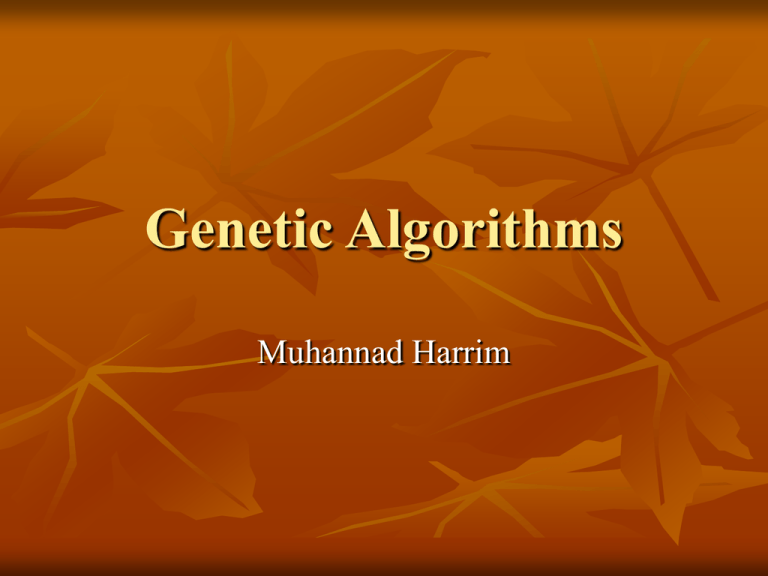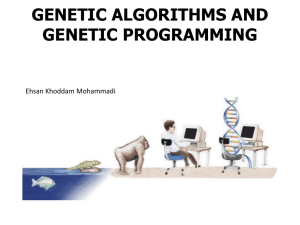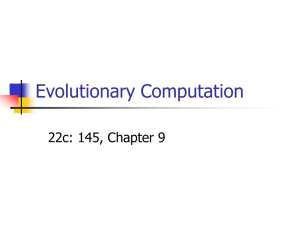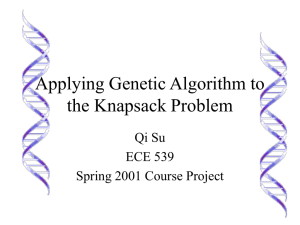Genetic-Algorithms
advertisement

Genetic Algorithms
Muhannad Harrim
Introduction
After scientists became disillusioned with
classical and neo-classical attempts at
modeling intelligence, they looked in other
directions.
Two prominent fields arose, connectionism
(neural networking, parallel processing) and
evolutionary computing.
It is the latter that this essay deals with genetic algorithms and genetic programming.
What is GA
A genetic algorithm (or GA) is a search technique
used in computing to find true or approximate
solutions to optimization and search problems.
Genetic algorithms are categorized as global search
heuristics.
Genetic algorithms are a particular class of
evolutionary algorithms that use techniques inspired
by evolutionary biology such as inheritance,
mutation, selection, and crossover (also called
recombination).
What is GA
Genetic algorithms are implemented as a computer
simulation in which a population of abstract
representations (called chromosomes or the genotype
or the genome) of candidate solutions (called
individuals, creatures, or phenotypes) to an
optimization problem evolves toward better solutions.
Traditionally, solutions are represented in binary as
strings of 0s and 1s, but other encodings are also
possible.
What is GA
The evolution usually starts from a population of
randomly generated individuals and happens in
generations.
In each generation, the fitness of every individual in
the population is evaluated, multiple individuals are
selected from the current population (based on their
fitness), and modified (recombined and possibly
mutated) to form a new population.
What is GA
The new population is then used in the next
iteration of the algorithm.
Commonly, the algorithm terminates when
either a maximum number of generations has
been produced, or a satisfactory fitness level
has been reached for the population.
If the algorithm has terminated due to a
maximum number of generations, a
satisfactory solution may or may not have been
reached.
Key terms
Individual - Any possible solution
Population - Group of all individuals
Search Space - All possible solutions to the problem
Chromosome - Blueprint for an individual
Trait - Possible aspect (features) of an individual
Allele - Possible settings of trait (black, blond, etc.)
Locus - The position of a gene on the chromosome
Genome - Collection of all chromosomes for an
individual
Chromosome, Genes and
Genomes
Genotype and Phenotype
Genotype:
– Particular set of genes in a genome
Phenotype:
– Physical characteristic of the genotype
(smart, beautiful, healthy, etc.)
Genotype and Phenotype
GA Requirements
A typical genetic algorithm requires two things to be defined:
a genetic representation of the solution domain, and
a fitness function to evaluate the solution domain.
A standard representation of the solution is as an array of bits.
Arrays of other types and structures can be used in essentially
the same way.
The main property that makes these genetic representations
convenient is that their parts are easily aligned due to their
fixed size, that facilitates simple crossover operation.
Variable length representations may also be used, but
crossover implementation is more complex in this case.
Tree-like representations are explored in Genetic
programming.
Representation
Chromosomes could be:
Bit strings
Real numbers
Permutations of element
Lists of rules
Program elements
... any data structure ...
(0101 ... 1100)
(43.2 -33.1 ... 0.0 89.2)
(E11 E3 E7 ... E1 E15)
(R1 R2 R3 ... R22 R23)
(genetic programming)
GA Requirements
The fitness function is defined over the genetic representation
and measures the quality of the represented solution.
The fitness function is always problem dependent.
For instance, in the knapsack problem we want to maximize
the total value of objects that we can put in a knapsack of some
fixed capacity.
A representation of a solution might be an array of bits, where
each bit represents a different object, and the value of the bit (0
or 1) represents whether or not the object is in the knapsack.
Not every such representation is valid, as the size of objects
may exceed the capacity of the knapsack.
The fitness of the solution is the sum of values of all objects in
the knapsack if the representation is valid, or 0 otherwise. In
some problems, it is hard or even impossible to define the
fitness expression; in these cases, interactive genetic
algorithms are used.
A fitness function
Basics of GA
The most common type of genetic algorithm works like this:
a population is created with a group of individuals created
randomly.
The individuals in the population are then evaluated.
The evaluation function is provided by the programmer and
gives the individuals a score based on how well they perform
at the given task.
Two individuals are then selected based on their fitness, the
higher the fitness, the higher the chance of being selected.
These individuals then "reproduce" to create one or more
offspring, after which the offspring are mutated randomly.
This continues until a suitable solution has been found or a
certain number of generations have passed, depending on the
needs of the programmer.
General Algorithm for GA
Initialization
Initially many individual solutions are randomly
generated to form an initial population. The
population size depends on the nature of the problem,
but typically contains several hundreds or thousands
of possible solutions.
Traditionally, the population is generated randomly,
covering the entire range of possible solutions (the
search space).
Occasionally, the solutions may be "seeded" in areas
where optimal solutions are likely to be found.
General Algorithm for GA
Selection
During each successive generation, a proportion of the existing
population is selected to breed a new generation.
Individual solutions are selected through a fitness-based
process, where fitter solutions (as measured by a fitness
function) are typically more likely to be selected.
Certain selection methods rate the fitness of each solution and
preferentially select the best solutions. Other methods rate only
a random sample of the population, as this process may be
very time-consuming.
Most functions are stochastic and designed so that a small
proportion of less fit solutions are selected. This helps keep the
diversity of the population large, preventing premature
convergence on poor solutions. Popular and well-studied
selection methods include roulette wheel selection and
tournament selection.
General Algorithm for GA
In roulette wheel selection, individuals are
given a probability of being selected that is
directly proportionate to their fitness.
Two individuals are then chosen randomly
based on these probabilities and produce
offspring.
General Algorithm for GA
Roulette Wheel’s Selection Pseudo Code:
for all members of population
sum += fitness of this individual
end for
for all members of population
probability = sum of probabilities + (fitness / sum)
sum of probabilities += probability
end for
loop until new population is full
do this twice
number = Random between 0 and 1
for all members of population
if number > probability but less than next probability then
you have been selected
end for
end
create offspring
end loop
General Algorithm for GA
Reproduction
The next step is to generate a second generation population of
solutions from those selected through genetic operators:
crossover (also called recombination), and/or mutation.
For each new solution to be produced, a pair of "parent"
solutions is selected for breeding from the pool selected
previously.
By producing a "child" solution using the above methods of
crossover and mutation, a new solution is created which
typically shares many of the characteristics of its "parents".
New parents are selected for each child, and the process
continues until a new population of solutions of appropriate
size is generated.
General Algorithm for GA
These processes ultimately result in the next
generation population of chromosomes that is
different from the initial generation.
Generally the average fitness will have
increased by this procedure for the population,
since only the best organisms from the first
generation are selected for breeding, along
with a small proportion of less fit solutions, for
reasons already mentioned above.
Crossover
the most common type is single point crossover. In single
point crossover, you choose a locus at which you swap the
remaining alleles from on parent to the other. This is complex
and is best understood visually.
As you can see, the children take one section of the
chromosome from each parent.
The point at which the chromosome is broken depends on the
randomly selected crossover point.
This particular method is called single point crossover because
only one crossover point exists. Sometimes only child 1 or
child 2 is created, but oftentimes both offspring are created and
put into the new population.
Crossover does not always occur, however. Sometimes, based
on a set probability, no crossover occurs and the parents are
copied directly to the new population. The probability of
crossover occurring is usually 60% to 70%.
Crossover
Mutation
After selection and crossover, you now have a new population
full of individuals.
Some are directly copied, and others are produced by
crossover.
In order to ensure that the individuals are not all exactly the
same, you allow for a small chance of mutation.
You loop through all the alleles of all the individuals, and if
that allele is selected for mutation, you can either change it by
a small amount or replace it with a new value. The probability
of mutation is usually between 1 and 2 tenths of a percent.
Mutation is fairly simple. You just change the selected alleles
based on what you feel is necessary and move on. Mutation is,
however, vital to ensuring genetic diversity within the
population.
Mutation
General Algorithm for GA
Termination
This generational process is repeated until a
termination condition has been reached.
Common terminating conditions are:
A solution is found that satisfies minimum criteria
Fixed number of generations reached
Allocated budget (computation time/money) reached
The highest ranking solution's fitness is reaching or has
reached a plateau such that successive iterations no longer
produce better results
Manual inspection
Any Combinations of the above
GA Pseudo-code
Choose initial population
Evaluate the fitness of each individual in the population
Repeat
Select best-ranking individuals to reproduce
Breed new generation through crossover and mutation (genetic
operations) and give birth to offspring
Evaluate the individual fitnesses of the offspring
Replace worst ranked part of population with offspring
Until <terminating condition>
Symbolic AI VS. Genetic Algorithms
Most symbolic AI systems are very static.
Most of them can usually only solve one given
specific problem, since their architecture was
designed for whatever that specific problem was in
the first place.
Thus, if the given problem were somehow to be
changed, these systems could have a hard time
adapting to them, since the algorithm that would
originally arrive to the solution may be either
incorrect or less efficient.
Genetic algorithms (or GA) were created to combat
these problems; they are basically algorithms based
on natural biological evolution.
Symbolic AI VS. Genetic Algorithms
The architecture of systems that implement genetic algorithms
(or GA) are more able to adapt to a wide range of problems.
A GA functions by generating a large set of possible solutions
to a given problem.
It then evaluates each of those solutions, and decides on a
"fitness level" (you may recall the phrase: "survival of the
fittest") for each solution set.
These solutions then breed new solutions.
The parent solutions that were more "fit" are more likely to
reproduce, while those that were less "fit" are more unlikely to
do so.
In essence, solutions are evolved over time. This way you
evolve your search space scope to a point where you can find
the solution.
Genetic algorithms can be incredibly efficient if programmed
correctly.
Genetic Programming
In programming languages such as LISP, the mathematical
notation is not written in standard notation, but in prefix
notation. Some examples of this:
+21
:
2+1
*+212
:
2 * (2+1)
*+-2149 :
9 * ((2 - 1) + 4)
Notice the difference between the left-hand side to the right?
Apart from the order being different, no parenthesis! The
prefix method makes it a lot easier for programmers and
compilers alike, because order precedence is not an issue.
You can build expression trees out of these strings that then
can be easily evaluated, for example, here are the trees for the
above three expressions.
Genetic Programming
Genetic Programming
You can see how expression evaluation is thus a lot
easier.
What this have to do with GAs? If for example you
have numerical data and 'answers', but no expression
to conjoin the data with the answers.
A genetic algorithm can be used to 'evolve' an
expression tree to create a very close fit to the data.
By 'splicing' and 'grafting' the trees and evaluating
the resulting expression with the data and testing it to
the answers, the fitness function can return how close
the expression is.
Genetic Programming
The limitations of genetic programming lie in
the huge search space the GAs have to search
for - an infinite number of equations.
Therefore, normally before running a GA to
search for an equation, the user tells the
program which operators and numerical ranges
to search under.
Uses of genetic programming can lie in stock
market prediction, advanced mathematics and
military applications .
Evolving Neural Networks
Evolving the architecture of neural network is
slightly more complicated, and there have been
several ways of doing it. For small nets, a
simple matrix represents which neuron
connects which, and then this matrix is, in
turn, converted into the necessary 'genes', and
various combinations of these are evolved.
Evolving Neural Networks
Many would think that a learning function could be
evolved via genetic programming. Unfortunately,
genetic programming combined with neural networks
could be incredibly slow, thus impractical.
As with many problems, you have to constrain what
you are attempting to create.
For example, in 1990, David Chalmers attempted to
evolve a function as good as the delta rule.
He did this by creating a general equation based upon
the delta rule with 8 unknowns, which the genetic
algorithm then evolved.
Other Areas
Genetic Algorithms can be applied to virtually any problem
that has a large search space.
Al Biles uses genetic algorithms to filter out 'good' and 'bad'
riffs for jazz improvisation.
The military uses GAs to evolve equations to differentiate
between different radar returns.
Stock companies use GA-powered programs to predict the
stock market.
Example
f(x) = {MAX(x2): 0 <= x <= 32 }
Encode Solution: Just use 5 bits (1 or 0).
Generate initial population.
A
0
1
1
0
1
B
1
1
0
0
0
C
0
1
0
0
0
D
1
0
0
1
1
Evaluate each solution against objective.
Sol.
String
Fitness
% of Total
A
01101
169
14.4
B
11000
576
49.2
C
01000
64
5.5
D
10011
361
30.9
Example Cont’d
Create next generation of solutions
Probability of “being a parent” depends on the fitness.
Ways for parents to create next generation
Reproduction
Crossover
Cut and paste portions of one string to another.
Mutation
Use a string again unmodified.
Randomly flip a bit.
COMBINATION of all of the above.
Checkboard example
We are given an n by n checkboard in which every field
can have a different colour from a set of four colors.
Goal is to achieve a checkboard in a way that there are no
neighbours with the same color (not diagonal)
1
1
2
2
3
3
4
4
5
5
6
6
7
7
8
8
9
9
10
10
1
2
3
4
5
6
7
8
9
10
1
2
3
4
5
6
7
8
9
10
Checkboard example Cont’d
Chromosomes represent the way the checkboard is colored.
Chromosomes are not represented by bitstrings but by
bitmatrices
The bits in the bitmatrix can have one of the four values 0,
1, 2 or 3, depending on the color.
Crossing-over involves matrix manipulation instead of
point wise operating.
Crossing-over can be combining the parential matrices in a
horizontal, vertical, triangular or square way.
Mutation remains bitwise changing bits in either one of the
other numbers.
Checkboard example Cont’d
• This problem can be seen as a graph with n nodes
and (n-1) edges, so the fitness f(x) is defined as:
f(x) = 2 · (n-1) ·n
Checkboard example Cont’d
• Fitnesscurves for different cross-over rules:
Fitness
Lower-Triangular Crossing Over
Square Crossing Over
180
180
170
170
160
160
150
150
140
140
130
0
100
200
300
400
500
130
0
Fitness
Horizontal Cutting Crossing Over
180
170
170
160
160
150
150
140
140
0
200
400
Generations
600
400
600
800
Verical Cutting Crossing Over
180
130
200
800
130
0
500
1000
Generations
1500
Questions
??
THANK YOU








